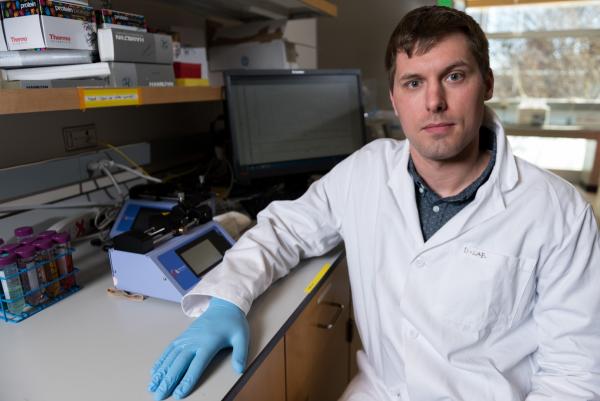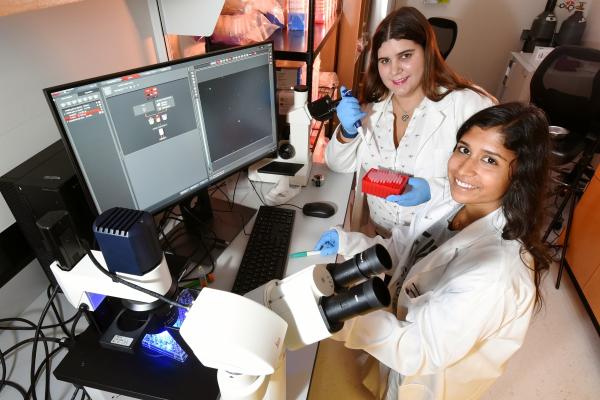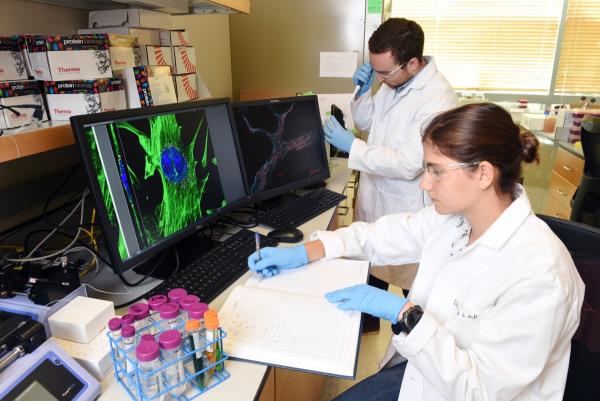Genetic testing today is mainstream, marketing to consumers who want to know where in Europe they came from or what types of hereditary diseases they could develop. For around $200 you can trace your family tree to learn your origins or identify genetic abnormalities that could signal disease. James Dahlman, assistant professor in the College of Engineering’s biomedical engineering department, specializes in genetics and believes these genotyping services can be helpful, as long as they are used responsibly.
“If you’re going to start making medical predictions, you have to be careful,” said Dahlman. “Most people are not equipped to interpret statistics correctly, which can lead to negative predicting and ethical dilemmas. In a few years, genetic counselors will be in high demand so folks can make better decisions about their health.”
Dahlman is fascinated by genetics, citing gene therapy as the most interesting field in the world. And it’s a field that he is revolutionizing through his research. Gene therapy is an experimental technique that uses genes to treat or prevent diseases, including hemophilia, Parkinson’s, cancer and HIV. It can help manage a number of diseases by leveraging genes instead of drugs or surgery. Although gene therapy shows promise, there are still risks involved, including unwanted immune system reactions or the risk of the wrong cells being targeted. That’s where Dahlman’s research comes in.
Dahlman’s lab focuses on drug delivery vehicles, which are nanoparticles. The nanoparticle delivers gene therapies to the right place in the body to fight disease. It’s critical that the gene therapies only target the unhealthy cells to avoid damaging healthy ones. Dahlman is laser focused on ensuring the nanoparticles know what paths to take to reach the correct organ to start the healing process.
“The issue with genetically-engineered drugs is that they don’t work unless they get to the right cell in the body,” said Dahlman. “You can have the world’s best genetic drug that's going to fix a tumor or eradicate plaque, but it’s not going to be effective unless it travels to the right organ. In my lab, we design different nanoparticles to deliver the genetically-engineered drugs to the correct location.”
Dahlman is redefining the field of genetic therapy with a testing system he invented called FIND (Fast Identifiable Nanoparticle Delivery). During the course of identifying effective nanoparticles for drug delivery, thousands of nanoparticles must be tested, which presents scalability issues. Mice must be used for the tests because a cell plate isn’t going to replicate organs in the human body. But ethically, researchers cannot inject thousands of mice for an experiment of this magnitude. So Dahlman developed a testing system that leverages DNA barcodes (a stand-in for the actual drugs) to label each nanoparticle. Once those are injected, researchers can see where the barcodes went in the mouse. For example, if a significant number of barcodes numbered 30 all went to the heart, Dahlman can deduce that the nanoparticle represented by barcode 30 is best suited for that organ.
“The barcode system is redefining our field because we are now able to do several really important things that we couldn’t before,” said Dahlman. “First, we can test thousands of nanoparticles at once, which has been a pipedream in our field forever. Second, we can now study the biology of drug delivery, understanding which genes affect how well a drug will work. And third, we can apply big data and artificial intelligence to drug delivery for the first time. With thousands of nanoparticles being tested at once, we can mine giant data sets for bioinformatics.”
Dahlman’s research and barcoding system has universal implications; he is designing testing systems that everyone can use. Labs across the country can leverage FIND to accelerate their studies. If the technology is used by more labs, Dahlman believes it will increase the rate that gene therapies are developed, advancing the entire field.
Non-liver gene therapy delivery is one of the biggest challenges today that Dahlman hopes to contribute to with his work. The liver has been easier to target with gene therapy because of its filtration system; larger blood vessels let the nanoparticles pass more easily into the organ. Diseases such as hepatitis and cirrhosis have responded well to gene therapies.
“All types of drug therapies have to be delivered,” said Dahlman. “Our field has had the best success with the liver, with 15 clinical trials already successfully running using the same nanoparticle delivery mechanism. The liver is responding extremely well to these therapies, and we are healing livers and curing people. The next frontier will be organs other than the liver, like the heart and brain with tighter blood vessel systems.”
After 12 months, Dahlman’s lab is coming into its own with nine graduate students and four undergraduates working in the lab. Much of the energy and excitement in Dahlman’s lab come from the fact that he is a young professor. He’s only 30 and easily relates to the students in his lab. Dahlman’s had great experiences with faculty members too and describes senior faculty as extremely helpful and supportive.
“I’ve gotten carded at two different faculty events, and I’ve been mistaken as a student more times than I can count!” said Dahlman. “But there haven’t been any challenges here with being a young faculty member. That was one thing that really attracted me to Tech – the young faculty seemed truly happy here.”
Dahlman’s personal and professional goal is to be working on high risk, innovative science for as long as possible. He never wants to be in a rut, and he wants to have the courage to pursue interesting and risky science even if lower risk work is safer. In his lab, his goal is to produce great students. In 20 years, he wants to see his students as leaders in the field.
“I want people to say, ‘That person went through the Dahlman lab, we have to hire them,’” said Dahlman. “That’s what I want for my students, and I think we can get there.”
By Georgia Parmelee
Media Contact
Walter Rich
Keywords
Latest BME News
Jo honored for his impact on science and mentorship
The department rises to the top in biomedical engineering programs for undergraduate education.
Commercialization program in Coulter BME announces project teams who will receive support to get their research to market.
Courses in the Wallace H. Coulter Department of Biomedical Engineering are being reformatted to incorporate AI and machine learning so students are prepared for a data-driven biotech sector.
Influenced by her mother's journey in engineering, Sriya Surapaneni hopes to inspire other young women in the field.
Coulter BME Professor Earns Tenure, Eyes Future of Innovation in Health and Medicine
The grant will fund the development of cutting-edge technology that could detect colorectal cancer through a simple breath test
The surgical support device landed Coulter BME its 4th consecutive win for the College of Engineering competition.










